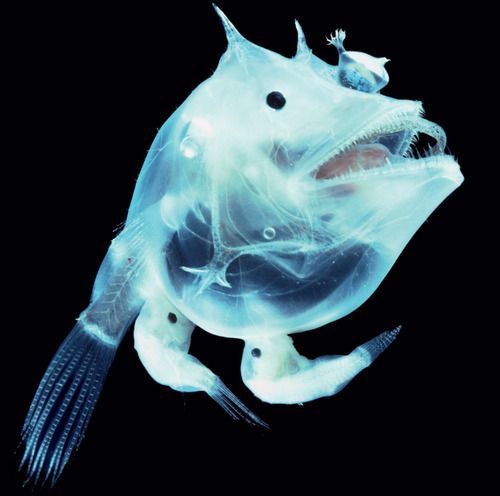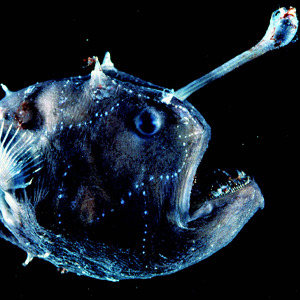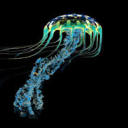Brittle Stars

Brittle Stars
Asteroschema Ajax
Brittle stars are in the phylum Enchinodermata and are closely related to sea stars. They have long stringy arms and small podia on the bottoms of their body. They also have a hydrostatic skeleton and have a complex water vascular system. When attacked, they will abandon their arm to confuse predators and make a hasty escape. The photo above is a deep sea brittle star that lives in coral reefs.
Photo credit: https://species.wikimedia.org/wiki/Asteroschema_ajax
More Posts from Bioluminescentoceangoddess and Others

Pram Bug
Phronima sedentaria
The Pram Bug is a deep sea amphipod that is located between 200 to 1000m in the ocean. It has a translucent exoskeleton and can see primarily blue light. It is also is contained in a hollowed out barrel that is used for protection and to house babies. The image above is a female pram bug carrying its young.
Photo Credit:https://ocean.si.edu/ocean-life/invertebrates/phronima-female-and-young

Glass Octopus
Vitreledonella richardi
The Glass Octopus spend its entire life in the midwater section of the ocean and found at depths between 200m to 2000m. Even though it has no protection from predators, it achieves perfect transparency. The only part of the Glass Octopus that is visible is its digestive gland. However, the digestive gland is placed vertically to minimize detection. In addition, I find this octopus to be super cute!
Photo credit: https://www.mynumer.com/forums/topic/499/invisible-animals/view/post_id/859

Vampire Squid
Vampyroteuthis infernalis
Even though the Vampire Squid is named after a notorious monster, this gentle creature does not live up to its name. It is only a foot long and occupies depths between 650m to 1500m in the deep ocean. Unlike other squids, it has reduced musculature and collects particles in the water column. However, it is capable of huge bursts of speeds. It uses bioluminescence to confuse both predators.
Photo credit: https://ocean.si.edu/ocean-life/invertebrates/vampire-squid-hell


Physonect Siphonophore
Nanomia cara
The Physonect siphonophore has tiny, bubble shaped sacs that are filled with gas. The sacs are called pneumatophores and help this creature move through the deep ocean. It also has venomous tentacles that stun prey and over eighty stomachs. There are numerous amounts of these strange creatures along the east coast, and they have cause some fisheries to collapse. Furthermore, they can be found at depth between 400m to 1000m.
Photo credit: http://www.seawater.no/fauna/cnidaria/cara.html
https://www.mindenpictures.com/stock-photo-siphonophore-hydrozoan-cnidarian-nanomia-cara-atlantic-nectophores-naturephotography-image90194961.html


Basket Star
Gorgonocephalus caputmedusae
The Basket Star is a strange yet elegant creature that lives in the deep ocean. It resembles a flesh white ball with gnarled and swirling branches. It thrives in locations with strong currents. Its numerous arms move slowly and wrap around prey. They are one of my favorite animals from the Echinodermata phylum.
Photo credit
https://link.springer.com/article/10.1007/s00227-005-0032-3
https://en.wikipedia.org/wiki/Gorgonocephalus

Periphyllopsis braueri
The Periphyllopsis braueri is a tiny, deep sea jellyfish that is only 6 cm in diameter. It is red-chocolate in color, and it has eight gonads. Furthermore, it is found at depths between 600m to 1000m.
Photo credit: https://oceanexplorer.noaa.gov/explorations/19gulfofalaska/logs/aug2/aug2.html

Crystal Jellyfish
Aequorea victoria
The Crystal Jellyfish is a graceful, transparent jellyfish with long, thin tentacles. It has bioluminescent organs around it bell that produce a bright, green light. It tends to consume small copepods, but it has the ability to swallow other jellyfish half its size. Furthermore, this jelly is used in biological experiments to detect calcium.
Photo credit: https://www.montereybayaquarium.org/animals/animals-a-to-z/crystal-jelly
https://fineartamerica.com/featured/5-aequorea-crystal-jellyfish-with-amphipods-alexander-semenovscience-photo-library.html


Deep-sea white anglerfish
Haplophryne mollis
The Deep-sea white anglerfish is a ghostly white creature found at depths between 1000m to 4000m. The strange bulge between its eyes is a bioluminescent lure. The main fish above is a female and the tiny fish attached to her body are males. Since it is difficult to find mates in the deep ocean, male fish latch onto the female with hooked teeth. Even though the male fish are parasitic, they are eventually reduced to pockets of sperm that are used for reproduction. For all you fellas out there that have a rough time with the ladies, be thankful that you are at least not a bag of gonads floating through the ocean.
Photo credit: https://www.pinterest.co.uk/pin/440297301041956897/
https://news.cgtn.com/news/3d3d414d3559444f7a457a6333566d54/share_p.html


Football Fish
Himantolophus paucifilosus
The Football fish is a deep sea angular fish located between 1000 to 4000 meters in the ocean. The glowing dots on its body are sensory organs called neuromast that help the fish detect changes in the water.
Photo credit: https://alchetron.com/Footballfish
https://www.amazon.com/Creatures-Deep-Search-Monsters-World/dp/1770852816


Blacksnout Seasnail
Paralipparis copei copei
The Blacksnout Seasnail may not look like a snail, but it does have a slimy, gelatinous substance that covers its body. It can be found at depths between 200 m to 1692 m, and adults grow up to be 17 cm in size (approximately 6.5 in). It also has an elongated body that resembles an eel. Furthermore, it can be seen rolling itself in a loop; this behavior is a defensive posture that makes it appear like a jelly. In the darkness, predators tend to avoid the Blacksnout Seasnail because its often mistaken as a hunter due to its appearance and behavior.
-
 faultyconnection-error2981046 liked this · 8 months ago
faultyconnection-error2981046 liked this · 8 months ago -
 sinbad-the-merchant liked this · 1 year ago
sinbad-the-merchant liked this · 1 year ago -
 corruptedstructure reblogged this · 1 year ago
corruptedstructure reblogged this · 1 year ago -
 nerdypersonamongerscissors liked this · 1 year ago
nerdypersonamongerscissors liked this · 1 year ago -
 stardustandmoonflowers liked this · 1 year ago
stardustandmoonflowers liked this · 1 year ago -
 bewrabawa reblogged this · 1 year ago
bewrabawa reblogged this · 1 year ago -
 bugfilledpurpleshoe liked this · 2 years ago
bugfilledpurpleshoe liked this · 2 years ago -
 saltmatchescandlewax reblogged this · 2 years ago
saltmatchescandlewax reblogged this · 2 years ago -
 hemulpajun reblogged this · 2 years ago
hemulpajun reblogged this · 2 years ago -
 hemulpajun liked this · 2 years ago
hemulpajun liked this · 2 years ago -
 amethysthorizon reblogged this · 3 years ago
amethysthorizon reblogged this · 3 years ago -
 wormslurry liked this · 3 years ago
wormslurry liked this · 3 years ago -
 vanillascenteddream liked this · 3 years ago
vanillascenteddream liked this · 3 years ago -
 redwolf1999 liked this · 3 years ago
redwolf1999 liked this · 3 years ago -
 plushypiglet liked this · 3 years ago
plushypiglet liked this · 3 years ago -
 pictures-and-things-321 liked this · 3 years ago
pictures-and-things-321 liked this · 3 years ago -
 omnifantasmic reblogged this · 3 years ago
omnifantasmic reblogged this · 3 years ago -
 sothatidostuff reblogged this · 3 years ago
sothatidostuff reblogged this · 3 years ago -
 hazeabiran reblogged this · 3 years ago
hazeabiran reblogged this · 3 years ago -
 blueorandas reblogged this · 3 years ago
blueorandas reblogged this · 3 years ago -
 blueorandas liked this · 3 years ago
blueorandas liked this · 3 years ago -
 cass-and-ras-world liked this · 3 years ago
cass-and-ras-world liked this · 3 years ago -
 moderngamebantam reblogged this · 3 years ago
moderngamebantam reblogged this · 3 years ago -
 moderngamebantam liked this · 3 years ago
moderngamebantam liked this · 3 years ago -
 darknovalatte liked this · 3 years ago
darknovalatte liked this · 3 years ago -
 maricruz-camacho liked this · 3 years ago
maricruz-camacho liked this · 3 years ago -
 cum--brulee liked this · 3 years ago
cum--brulee liked this · 3 years ago -
 hungryrascal liked this · 3 years ago
hungryrascal liked this · 3 years ago -
 idkaboutnames liked this · 3 years ago
idkaboutnames liked this · 3 years ago -
 brandnewtale liked this · 3 years ago
brandnewtale liked this · 3 years ago -
 twentybrokenipodclassics liked this · 3 years ago
twentybrokenipodclassics liked this · 3 years ago -
 sirneb liked this · 3 years ago
sirneb liked this · 3 years ago -
 hugolikesjellyfish reblogged this · 3 years ago
hugolikesjellyfish reblogged this · 3 years ago -
 holdmejustbecavse liked this · 3 years ago
holdmejustbecavse liked this · 3 years ago -
 peroxidebutch liked this · 3 years ago
peroxidebutch liked this · 3 years ago -
 energywaste liked this · 3 years ago
energywaste liked this · 3 years ago -
 astrotracksuitbattalion liked this · 3 years ago
astrotracksuitbattalion liked this · 3 years ago -
 rapsodiasatanica liked this · 3 years ago
rapsodiasatanica liked this · 3 years ago -
 evidenceofabsence liked this · 3 years ago
evidenceofabsence liked this · 3 years ago -
 lackluster-rat liked this · 3 years ago
lackluster-rat liked this · 3 years ago -
 mazapanmorena liked this · 3 years ago
mazapanmorena liked this · 3 years ago -
 labsforelves liked this · 3 years ago
labsforelves liked this · 3 years ago -
 redinthehood liked this · 3 years ago
redinthehood liked this · 3 years ago -
 the-drokainian liked this · 3 years ago
the-drokainian liked this · 3 years ago -
 cherry-bombbomb liked this · 3 years ago
cherry-bombbomb liked this · 3 years ago

Bioluminescence is a chemical reaction that produces light. Many deep sea animals use bioluminescence. This blog is dedicated to educating the public about the amazing creatures that thrive in the deep sea.
57 posts